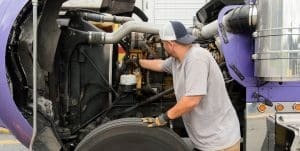Fleet managers understand the importance of data collection. After all, gathering fleet data is what leads to better business decisions and more efficient fleet operations. However, the reporting process itself is often quite time consuming, and for most fleet managers, this can be a challenge when trying to minimize downtime and maintain multiple fleet schedules. Since we know that these things are big to-dos for you at the end of each year, here are some ways that might help to streamline your reporting process, while keeping your data as accurate as possible.
A need for reliable data
Fleet managers bear the responsibility for a fleet’s overall efficiency and performance, so having accurate data is top priority. This data will steer most of the business decisions a fleet manager has to make, so it takes reliable data to make the most of resources while trucks are out on the road. But it’s not just cost reduction that benefits from accurate data. In fact, reliable data also helps fleet managers navigate regulatory compliance, tax deductions, purchasing decisions, driver performance metrics, and more.
Regulatory compliance
Fleet managers have to monitor their compliance with certain laws and regulations. These commonly deal with issues like parts and warranties, licensing, vehicle acquisitions, and safety concerns like recalls or risk mitigation measures.
Tax deductions
For tax deductions, fleet managers need to consistently log their fleet vehicle mileage. The IRS requires fleet businesses to report detailed operating expenses, and this includes the total accrued fleet mileage. Fleet managers need to have an efficient system in place to report this information correctly when tax season comes around.
Purchasing decisions
There comes a time when certain vehicles will begin to cost the fleet too much money for repairs and service. When this happens, a fleet manager will purchase a newer vehicle as a replacement. However, keeping tabs on these rolling costs can be a headache if not managed properly.
Driver performance metrics
Reliable data can also provide fleet managers with a snapshot of the average fuel consumption and mileage rates for each vehicle within their fleet. Knowing this information can help identify any outliers which may help point to underlying issues of driver dishonesty or poor performance. Fleet managers can avoid this if they are able to get ahead of the problem in time.
Automated data management systems
This is where automated data management systems can really make a difference. Whether keeping vehicles and equipment on their maintenance schedules, reducing labor costs, or tracking vehicle mileage, these data-driven systems can help mind the details and save fleets thousands of dollars. To minimize stress and the potential for errors when you’re doing this again next year, you’ll want to automate the process as much as possible
For example, our STEMCO Vehicle Technology (SVT™) products use smart technologies to simplify maintenance procedures, streamline data collection, and improve overall fleet safety. DataTrac® SVT hubodometers are read either by a fixed GateReader SVT, HandReader SVT, or Clarience Technologies trailer-mounted telematics system. Doing so eliminates the mistakes that often occur when collected by hand—a tedious method prone to human error, which can prove data unreliable and even lead to greater problems down the road.
Additionally, when DataTrac SVT mileage transmits via GateReader SVT or HandReader SVT, it is then transmitted to our STEMCO WebPortal SVT so that fleet managers can analyze and download the data using their WebPortal SVT login. It’s a convenient, fully automated process that is always up to date. And when managing a fleet of vehicles, that kind of peace of mind is worth its weight in gold.
Staying on top of maintenance
It’s no secret that a key to successful fleet management is maintaining consistent maintenance practices. Since most fleet maintenance occurs when hitting specific mileage markers, it’s vital to have accurate data across your entire fleet. This is the best way to ensure that your trucks are running at peak performance.
The problem is that many fleet managers still rely on collecting vehicle mileage information directly from drivers, either by hand or by analog sensors. Either way, these methods leave too much room for mistakes or general oversight, and while old habits are hard to break, an automated data management system can help protect your bottom line.
It may take some time to correct, but as the saying goes, “data is only as good as its ability to help us make good decisions.” Once you have the data to make a more informed decision about your maintenance practices, you can begin to implement changes that will benefit your business for years to come.
For more information on STEMCO Vehicle Technology (SVT), visit our product page or contact us directly.







